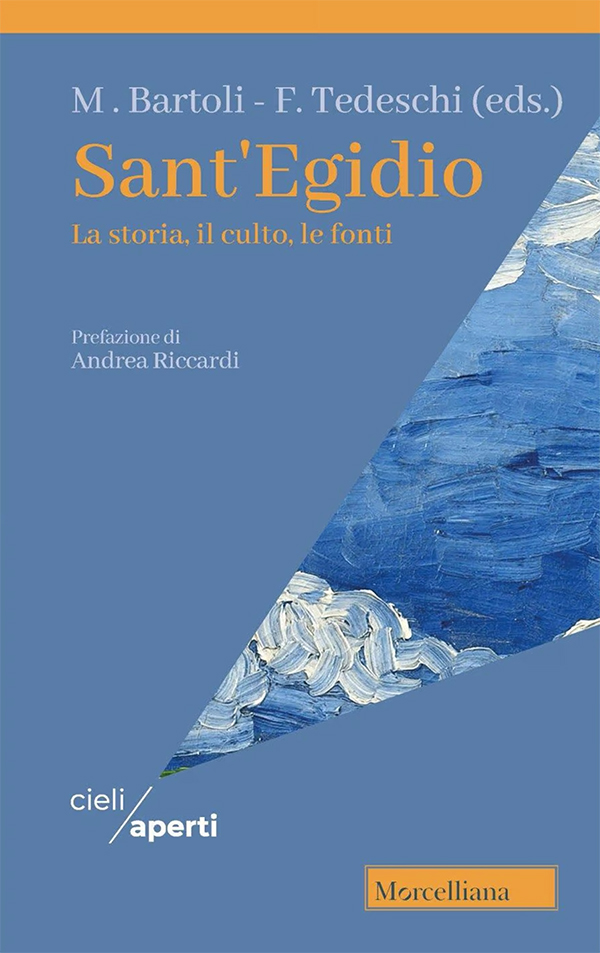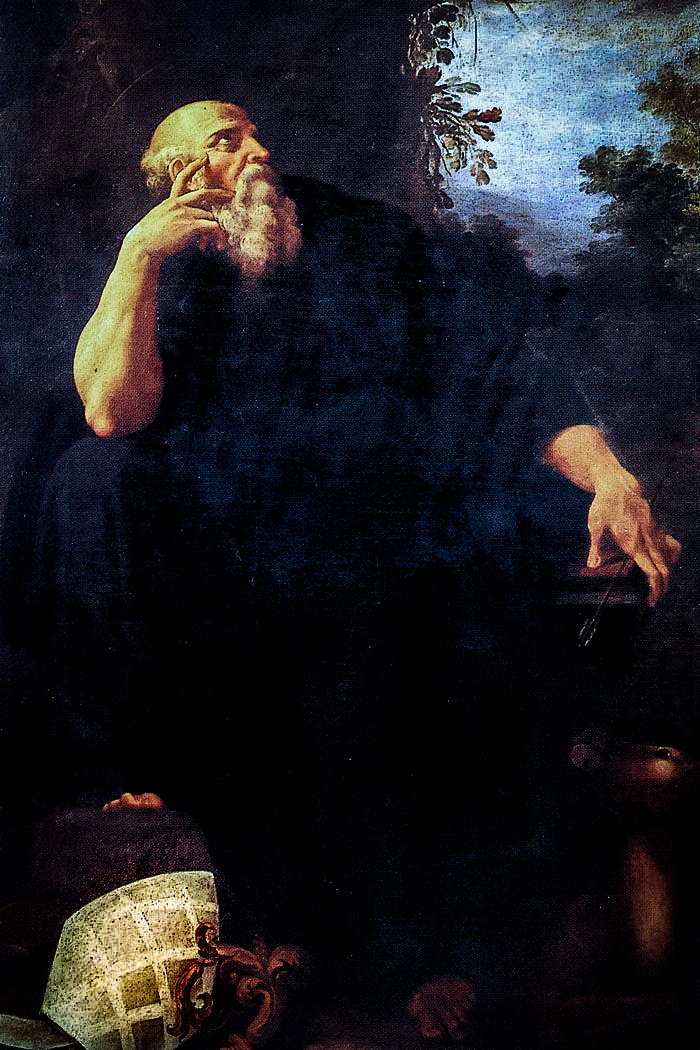at the presentation of the book "Sant'Egidio: la storia, il culto, le fonti"
First of all, I would like to thank Chiara Mercuri, André Vauchez, and Luigi Frudà for being with us and for their contributions to the launch of this book, Sant’Egidio: la storia, il culto e le fonti. The story of Sant’Egidio is as mysterious as an early medieval story can be. But the death, the extinguishing, the fragmentation of the cult of Sant’Egidio are mysterious too. He was a saint with a European scale popularity, centered in the shrine of Saint-Gilles du Gard as the main place where the gratitude of the faithful could be expressed. It was a stopping place along the pathway to Compostela, the route of the pilgrimage to the Holy Land, and the journey to Rome. But Sant’Egidio has also disappeared. His cult has survived just in a local dimension. It was even a neglected cult. According to the biblical, the Jewish, and also the Christian visions, a name means much. It has an intensity, a story, it denotes a vocation and a mission. But because of that fragmentation of the cult of Sant’Egidio there were many local ‘Sant’Egidios’, with rather different stories. His biography, placed in a distant past, a bit complicated and full of lacunae, it was difficult to remember. It is not the story of Francis of Assisi, nor is the story of Gregory the Great. His story is difficult to hand down to popular piety. Nevertheless, his name has become a miraculous name in so many places. In Saint-Gilles du Gard there are the remains of the abbey, symbol of the undivided Church, yet destroyed during the Wars of Religion.
The cult got lost during the French Revolution. Today a restored Sant’Egidio can be visited in that little village, 10,000 inhabitants, of Occitanie, in the Petite Camargue. It is a Sant’Egidio ‘sieged’ by dwellers who have not got French origins for the most part: there are many North Africans; close to them there are some Roma. I find that interesting. It is a great image: an abandoned church, or at the least deprived of its past greatness. I cannot help remembering the fire of Notre Dame, which drove me to write a book about the present situation of the Church: La Chiesa brucia? Is the Church Burning? With a question mark. Do those ruins of churches, those remains, those mute churches show that the Church is burning? I think that today, rather than burning, the Church is frozen, worn out by the lack of warmth of the faithful, the low number of vocations, the coldness of society. That is to say by its negligibility. In September 1973, we got to know the actual condition of abandonment of the little church of Sant’Egidio in Trastevere, where the Carmelite nuns had been lived from 1610 to 1972. They had moved to a monastery in Pescara. They were poor nuns: after the suppression of the religious orders in the 1860s, they had to leave the main part of the monastery, that had become a health centre for the fight against malaria, dedicated to Ettore Marchiafava, a great physician and hygienist, and had retired in an annex of Sant’Egidio, in a heavily damaged accommodation, in the cold. At Sant’Egidio we have begun to love the churches in ruins and to rebuild them. That was the case for Sant’Egidio itself. I would like to mention a book by Tommaso Montanari about the closed churches: they used to mean a great deal to generations, but now they are losing their significance. He writes: «Today we do not know what to do with all this abundance!» We do not know what to do with them! I remember a bishop who said: «I have one thousand churches in my Diocese!» Once, their predecessors would have said: «What a great treasure!» But he said that nearly with tears in his eyes. The French photographer Francis Meslet, who has published tragic photos about churches in ruins, speaks of the ‘pathetic character of the decay’: «True masterpieces, once great, then symbols of the break with the past, the break with one’s roots».
Secularization is not the point alone, the point is a Christianity no longer nourished by history, an emotional Christianity, a Christianity with no culture. In a word, the decline of the Church is also the end of the names of many churches: closed churches, churches sold for other uses. Then, so many questions: what to do? Keeping all those churches? Doesn’t it mean making the Church a museum? We presented a project to keep part of the ancient churches open, employing people, particularly foreign people, in order to include them, while keeping the churches open and preserving them at the same time. That bond with the churches which had once been something, and with the little church of Sant’Egidio, led the Community to repopulate the church of Sant’Egidio in Rome and to take its name after the saint to whom that church was dedicated. Many ask: «Why is your name Sant’Egidio?» Getting into Sant’Egidio’s convent was the opportunity to become acquainted with the story of the saint. A name is not only a matter of toponymy.
The dialogue with that story let a fondness and a free syntony emerge. We are attuned with that figure of ‘pater pauperum’, father of the poor. And Pope Francis, in a visit to Santa Maria in Trastevere, said: «Sant’Egidio is three Ps: poor, prayer, peace». I think that this is a meaningful aspect of our story: a fondness and a syntony. Becoming rooted in a story, the story of Sant’Egidio or others, is a way to find one’s freedom before the future, while a Christianity with no names, no history, no saints is a Christianity with no culture. The story of the Community of Sant’Egidio was also a story of renovation and revival of ancient churches, in the center of the town. That was the case for San Bartolomeo all’Isola Tiberina, with its memorial of the New Martyrs, a church that dates back to the time before the separation between East and West, at the time of Sant’Adalberto. That was the case for an old church in Ostia that was reopened; for San Michele, renovated; for two little churches downtown transformed into shelters for homeless people. That is the transformation of Santa Maria in Trastevere as well: it was a dilapidated basilica in the city centre, enormous, too large for being an ordinary parish church. Moreover, the people of Trastevere were characterized by a scarce attendance at church. Trastevere was the most anticlerical neighbourhood in Rome. The reports of the pastoral visitations of the 1920s expose a very ‘dangerous’ situation. It was said that during the occupation the German troops did not like to walk in the street of Trastevere. The people of Trastevere had a strong relation with the church solely regarding some intense occasions like baptisms, weddings, funerals. Actually, Santa Maria was an empty church. This is the way Montanari describes Santa Maria in Trastevere today: «Now the churches could become places where tangible and corporal assistance can be provided.
The Christmas Lunch with the poor people, that is arranged by the Community of Sant’Egidio every year is a powerful sign. It is the redeeming strength of art, it’s a liberating power. Besides it suggests that many other monumental churches could be used to welcome, nurse and take care of many, while keeping and protecting the monument closely, and giving it back its whole meaning. Combining care for ancient stones and care for living people». Truly, the Christmas Lunch is of the same logic as Saint Francis’ Nativity. The story of our relationship with Sant’Egidio means inhabiting his name once again, living in the place and having a ‘conversation’ with the name. I think that a Christian story – whatever you may think about it – going forward illuminated by the reading of the Bible, cannot fail to have a ‘conversation’ with moments and figures of our common history. For the Community of Sant’Egidio it was so in the relations with Francis of Assisi, with St Benedict, more humbly with Sant’Egidio, and even with many other great and living Christian figures, maybe uncanonized, but indeed meaningful. Let me finish with some Marco Bartoli’s words: «His shrine has become a destination for pilgrimages and his fame has spread all over Europe. We can say that he was stronger than wars and destructions and he was able to speak to the faith and the culture of peoples far from each other».















